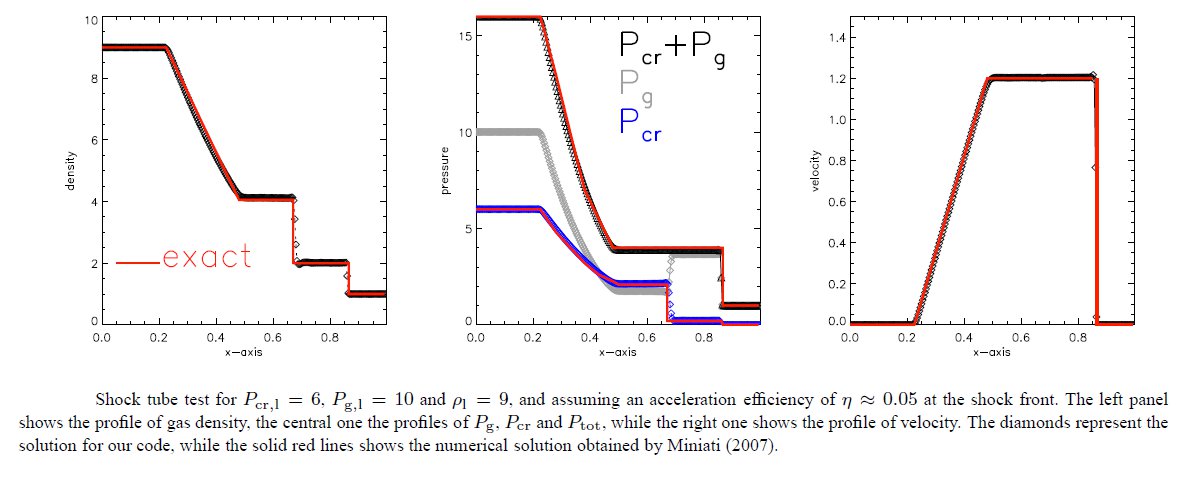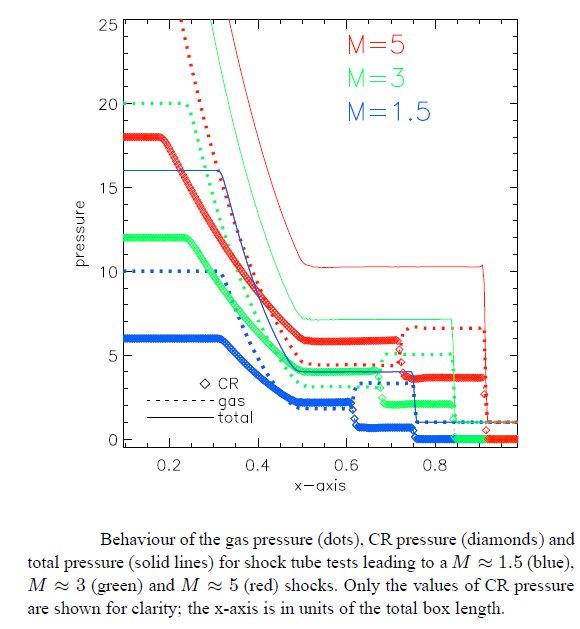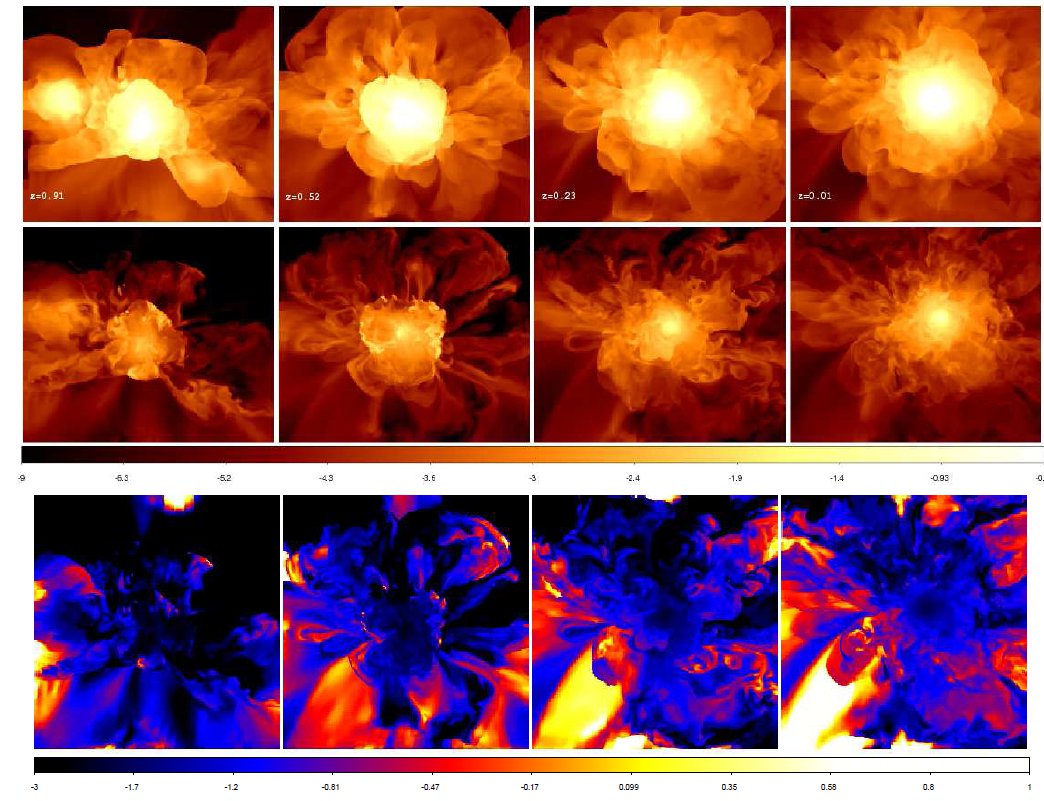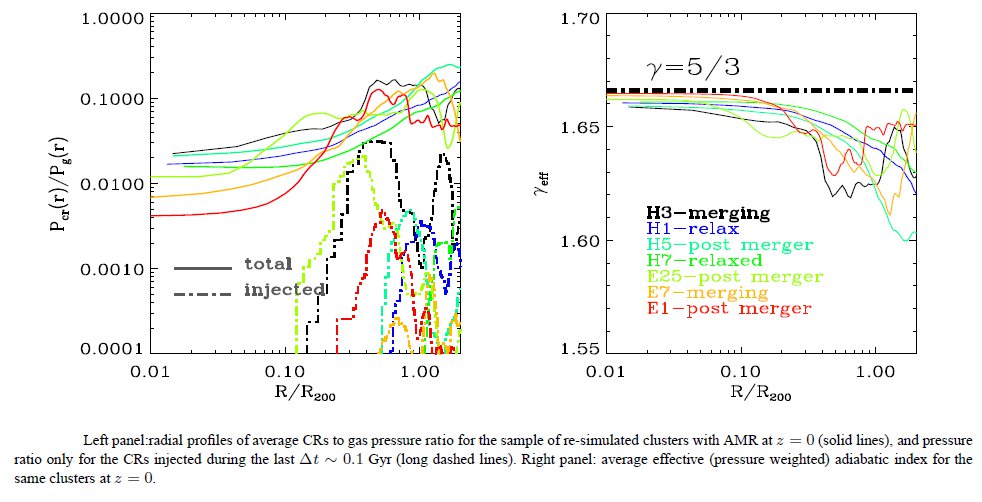sciENZO
(shock-injected-cosmic rays in ENZO)
Large Scale Shocks are responsible for the heating of the ICM and can be important sources of Cosmic Rays (CR) in the Universe.
In a first article, we presented an original implementation to model at run-time the injection, advection and dynamical feedback of CR in
cosmological simulations (also using AMR) working on the public 1.5 release of ENZO. This implementation is mostly based
on "pioneristic" works proposed by several people >10 years ago (T.Jones, H.Kang, F.Miniati...), which we tried
to merge within ENZO and using adaptive mesh refinement in cosmology
Read the full article here (Vazza, Bruggen, Gheller & Brunetti 2012 MNRAS)
Also the violent energy release which is supposed to operate during feedback from Active Galactic Nuclei onto
the intra cluster medium can enrich galaxy clusters with CRs.
In a second work, we studied this topic by implementing basic recipes of AGN feedback in ENZO simulations, modelling
several "flavors" of feedback: kinetic energy input from jets, theral energy input from "quasars", and buoyant
rise of evacuated bubbles. We studied the way each of these mechanisms should inject CRs in the ICM, and we
evolved galaxy clusters also following radiative cooling and energy losses of CRs. We produced forecasts of X-ray, gamma-ray emission and turbulent features connected to each feedback model, which are almost within reach of existing telescopes, and can
set upper-limits on the energetics and duty cycle of AGN feedback withi clusters when complemented with the
information provided by CRs.
Read the full article here (Vazza, Bruggen, Gheller 2012 MNRAS)
Tests
We tested our procedure against shock-tubes tests and 1-D zeldovich collapse test, finding very good performances.
Our code allows us to test the various "blocks" of CR physics (i.e. advection, injection, reduced thermalization, pressure feedback)
separately. Also the efficiency of acceleration with M can be varied.
 |
 |
Results
We investigated the distribution of CR in large scale structures, using both fixed grid runs (dx=200kpc/h) and runs with adaptive mesh refinement (dx=25kpc/h).
The most important findings are:
- The level of CR energy inside cosmic structures is found to
be
small, Pcr/Pg < 0.1, with a peak at the over-density
typical of
outer accretion regions. We report that only the distribution of CRs outside of cosmic structures is strongly dependent on the details
involved in the acceleration in the early cosmic epochs (and in the most rarefied environments) while the distributions of CRs are very
stable for the innermost regions of clusters.
- In massive galaxy clusters, the dynamical role of
accelerated CR
energy is always quite small, and plays a
significant dynamical role only close to ∼ R200. In the centre of clusters instead the pressure of CRs is small, Pcr/Pg ∼ 0.02 −
0.05. These values are presently consistent with the upper-limits provided from γ-ray observations.
- The effects of CRs on the overall evolution of clusters have
small and systematic effects on the 3–D distribution of the
thermal
baryonic gas. In all re-simulated clusters in the innermost gas density, temperature and entropy are reduced by a few percent,
while they are enhanced on average by the same amount at R200. This comes from the fact that CRs first modify the
compressibility of outer accretion regions during the formation of structures, leading to an enhanced post-shock compression and to
a slightly faster expansion of the outer cluster layers compared to standard simulations.
- This produces also a corresponding decrease of X-ray
emission and
of the thermal SZ signal from the inner cluster
region, and an enhancement of a factor ∼ 0.4−4 close to R200, and depending of the dynamical state of the clusters.
- These systematic trends in galaxy clusters are at variance with SPH simulations, where rather opposite trends are reported.
COSMOLOGICAL RUN USING AMR (the movie is embedded in Youtube)
HERE IS A MOVIE SHOWING THE EVOLUTION OF GAS PRESSURE AND CR PRESSURE IN TWO RESIMULATIONS
OF THE SAME CLUSTERS, USING PURE COOLING OR FEEDBACK BY JETS (the movie is embedded in Youtube)
 slices of Mach number (measured at run-time), injected CR energy flux in the post-shock, and gas energy for a cluster simulated with AMR and our sciENZO modules. |
 Merger sequence for a cluster simulated with AMR. Top row: gas energy for a slice of 50 kpc/h. Middle row: CR energy within the same slice. Bottom row: ratio of the two for the same regions. |
 |